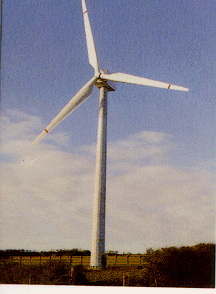Control of Wind Turbines
|
In pitch regulated wind turbines, the power output is
regulated by adjusting the angle of the turbine blades to compensate
for wind speed variations. However, the active regulation
of wind turbines presents a challenging control problem.
-
The aerodynamic characteristics of the rotor are
highly nonlinear.
-
A primary control objective is to alleviate loads
throughout the turbine in order to minimise fatigue damage.
This is nonlinear requirement which places little penalty
on normal operating loads but a great penalty on occasional
high loads.
-
The actuator bandwidth is low with tight rate limits.
|

|
|
Constant-speed wind turbines
Gain-scheduled control of constant-speed wind
turbines
Owing to the nonlinearity of the aerodynamics, a single linear
time-invariant controller is inadequate. The standard approach is
to employ a gain-scheduled controller. Provided that an appropriate
controller realisation is adopted, gain-scheduled control has been found
to be extremely successful in practice.
However, the conventional justification for the gain-scheduling
approach is invalid since the wind speed varies rapidly across the entire
operating envelope and prolonged gusts lead to sustained operation far
from equilibrium. The velocity-based
framework (the derivation of which was originally motivated by this
deficiency) provides a rigorous justification for the success of the gain-scheduling
approach in the context of constant-speed wind turbines.
Nonlinear control of constant-speed wind turbines
Conventional controllers employ gain-scheduling solely to compensate
for the nonlinear aerodynamics. However, the control objectives
are also nonlinear. By adopting a nonlinear control strategy, substantial
improvements in performance are possible. See on-line reports.
Accommodating actuator constraints
Owing to the large inertia of the rotor blades, wind turbine actuators
are generally of low bandwidth and are subject to strict position and
rate constraints. The transients associated with encountering the
position constraints can lead to a large performance degradation.
It has been found that, owing to the presence of both integral action
and a low-frequency pole in the controller, conventional anit-wind-up
methods are ineffective at reducing these transients and novel measures
must be adopted. The transients associated with the actuator
rate constraints have little direct impact of performance. However,
these constraints can lead to a considerable reduction in the stability
margins with a consequent requirement for controller de-tuning.
Variable-speed wind turbines
Previous research on constant-speed wind turbines has shown that
considerable performance improvements can be obtained by adopting appropriate
controller realisations and nonlinear control strategies. The application
of similar approaches to variable-speed wind turbines is currently the
subject of an extended investigation.
Previous renewable energy projects
include:
|
Design
and test of a controller for a variable speed wind turbine
|
|
The
dependence of control systems performance on the wind turbine configuration
|
|
Strategies
for the control of variable speed HAWT's
|
|
>An
investigation of the benefits of nonlinear control for pitch regulated
wind turbines.
|
|
An
investigation of the design of the power-train for constant speeds
HAWTS
|
|
Investigation
of control characteristics of advanced wind turbines
|
|
Investigation
of control strategies for VS45
|
|
Application
of MBPC to wind turbines
|
